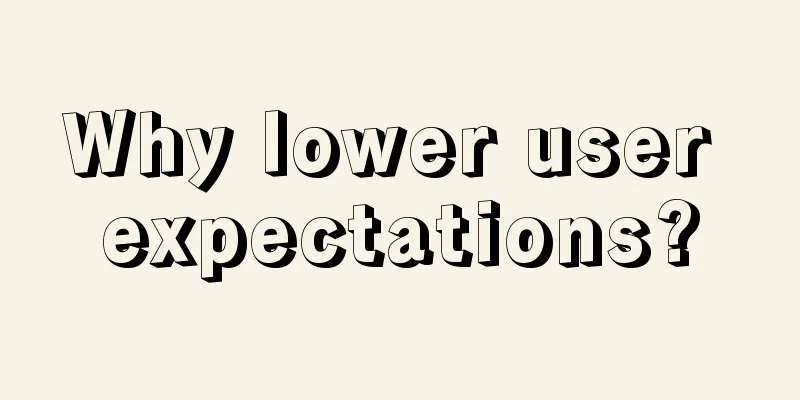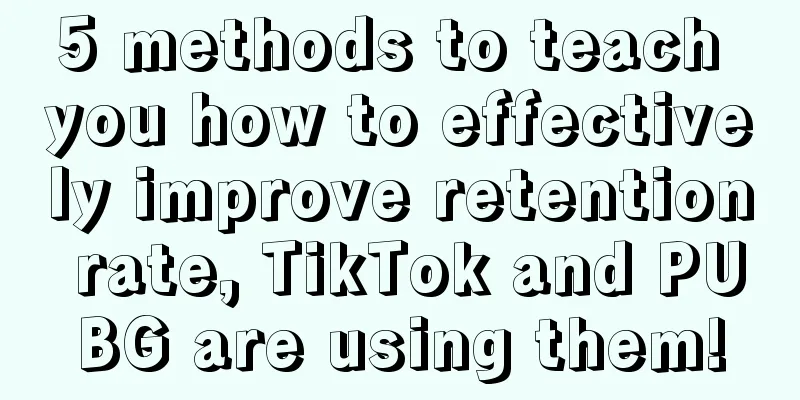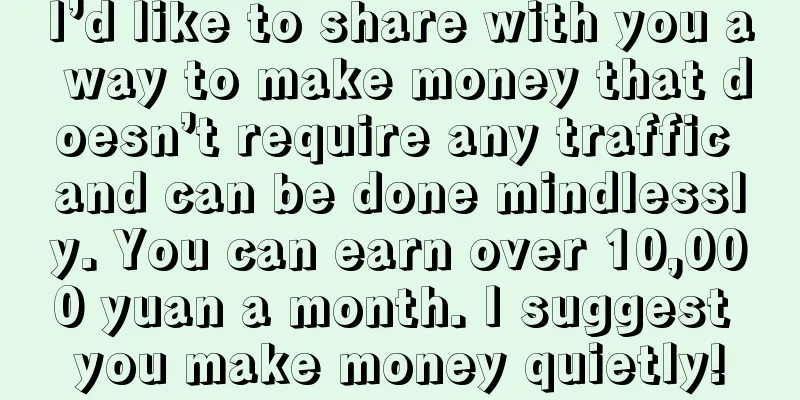Why lower user expectations?

|
Killing users’ unnecessary expectations and overly high expectations can enhance the value of the product and achieve sustainable growth of the product from a longer-term perspective. 1. Why should we lower user expectations? 1) “Do the opposite and educate consumers” The process of satisfying consumers is the result of users’ expectations being well met by the actual perceived quality. From the developer’s perspective, we assume users’ expectations and guide product iterations by improving the perceived quality of products. Similarly, we can also do the opposite and assume that the perceived quality of the product is already top-notch in the market. By lowering the user's inherent expectations, we can achieve perceived quality that exceeds the user's expectations, thereby improving user satisfaction. 2) “Water can carry a boat, but it can also capsize it” User expectations are extremely important. This is almost a familiar nonsense. How to grasp the degree is the key. Too many companies exaggerate their products when promoting them, attracting a large number of users out of curiosity. However, during actual use, it was discovered that the product experience did not match the high expectations brought by the promotion, which led to the company being "unfollowed, unliked, and turned into a hater." This is actually because the perceived value and expectation management of the product are not done well. For example: The product launches of Smartisan Technology were always packed, but the products were always criticized. As for the Xiaomi MIUI10 operating system that was just pushed out two days ago, it took half a year from vigorous promotion to the push of the stable version, which inadvertently raised users' expectations. Even though it is now relatively smooth and functional, it is still difficult to match the expectations generated by users during half a year of fermentation, and there is still a lot of criticism online. 3) “Reverse Observation” of Fogg’s Behavior Model In Fogg's behavioral model, we approximate expectations to motivation. In the process of continuously lowering expectations, the ability to acquire products is constantly increasing (the range of required capabilities is gradually becoming wider). In other words, as expectations decrease, users are more likely to be surprised by the product. Killing users’ unnecessary expectations and overly high expectations can enhance the value of the product and achieve sustainable growth of the product from a longer-term perspective. 2. Traditional Strategies to Lower User Expectations Strategy = Lowering user expectations + satisfying user expectations (expectations after lowering) The strategy of lowering user expectations is not uncommon. In the traditional after-sales consultation process, customer service's combination of "passing the buck first and solving the problem later" is to first lower user expectations and then provide help within the scope of their rights. For example: During consultation and training within the telecommunications bureau , when faced with unreasonable requests, customer service will be asked to first politely state that this is not something they can decide, and then propose services they can provide or solutions as an outsider to help users solve the problem. This combination of measures lowers user expectations while actually solving their problems, thereby creating a sense of superior service. There are many similar marketing strategies in traditional industries. You can have fun and look at this slogan: The catchy slogan conveys two messages: One is constantly lowering prices; Another is to continuously lower the psychological expectation of the corresponding price of the product, from the fantasy of 998 for a "high-quality brand " shoe to 198 for a "high-quality" shoe, while reducing the psychological purchasing power of 198 currency, thereby promoting consumer purchases. 3. Internet ideas to lower user expectations Friends may have a question: traditional customer service and advertising lower user expectations through some seemingly low-level methods, which seems to have nothing to do with Internet products. Of course, I am not asking you to apply these two cases, but in fact, Internet products have never stopped pursuing the goal of lowering user expectations. Idea = Change user expectations focus 1) Product UI design “I have a bottom line” may seem like a witty joke, but it also saves Alipay users the energy of scrolling down endlessly. The suggestive joke also lowers users’ expectations of scrolling down, drawing their attention back to the product itself. Idea = Achieve differentiated transformation of user expectations 2) Product tonality design - "Dating or flirting?" In recent years, social applications centered on "dating" have become very saturated, and LBS positioning + "face-based" social networking has almost become the main theme of the market. The needs of users cultivated in this market environment are also quite direct - the desire for "dating". This high expectation of "dating" is a key factor that hinders the emergence of differentiated social products in the market. Here is how to lower the expectations of dating. Let's see how Soul, which focuses on soul social networking, does it: The matching mechanism centered on testing (LBS positioning is cancelled): The basis for matching is the test results taken by the user above. The test is divided into three stages: elementary, intermediate and advanced. The test results will include multiple dimensions such as world outlook, values, feelings, preferences and tastes. Soul will select people with a high match rate to chat with users based on the personal characteristics obtained from the test. The planet is formed by 3D surrounding of many users with descriptive tags. Users can find users of interest and chat with them based on their favorite tags, and can refresh the users they see by rotating the galaxy. The voice matching in robot matching further reduces all imaginations about "dating", or in other words, extends the timeline of the dating behavior, and then provides feedback through in-depth communication. Idea = Focus on some users’ expectations and ignore others 3) Product misalignment strategy - Pinduoduo Pinduoduo CEO Huang Zheng explained Pinduoduo's rapid momentum as follows: By leveraging misaligned competition and social marketing ( WeChat ) + low-price strategy (supply chain), we have achieved viral growth. If you think about this sentence carefully, you can clearly find that Huang Zheng is actually talking about Pinduoduo's strategy of seizing consumers. Pinduoduo focuses on the general user groups with weak purchasing power, and through group buying, it lowers users' expectations for goods, thereby achieving a dislocation of product user groups. On the other hand, the actual purchasing phenomenon (mainly department store sales) can also illustrate the problem. Similar platforms: The same is true for Haoshiqi, which achieves product dislocation by focusing on low-priced high-end brand snacks (backlog of leftover goods). 4. Summary: Killing User Expectations 1) Disadvantages As mentioned at the beginning, this article is explained from the opposite angle of the previous article, that is, killing users' unnecessary expectations during the dissemination process is very beneficial to the market satisfaction of the product. But my premise is "communication process" and "unnecessary". If any one of these elements is abandoned or the reality is completely ignored, the effect cannot be guaranteed. 2) Three ways to kill user expectations
The views of this article are reserved, and "harassment" and discussion are welcome~ Source: |
<<: Mark's Favorite Musk July and August 2021 Courses
>>: All the strategies for advertising on new media platforms in 2018 are here!
Recommend
Why can't your interactive solution pass? Experts from big companies teach you these four methods!
This week, we specially invited Yi Yi, a former s...
12 golden rules for designing e-commerce operation tools
Although the tool itself is not easy to share, it...
What are the advantages of developing a mini program? What are the advantages of developing a tourism mini program?
Q: What are the advantages of developing a touris...
Smart TV: Standing at the forefront of artificial intelligence
Recently, it is the season for color TV manufactu...
A tourist drowned while swimming in Hainan, probably because he encountered this "invisible killer" on the beach!
Recently, a female netizen posted a message onlin...
Safety secrets on the return journey during the Spring Festival travel rush: Why don’t high-speed trains require seat belts?
There are seat belts on airplanes and cars, but w...
Scientists develop new coating to protect the largest million-kilowatt peak-shaving unit in Northwest China
Deserts, Gobi, Danxia, snow-capped mountains......
How to operate and promote WeChat public accounts
Whether it is a personal account or a corporate a...
Heilongjiang Province provides financial and taxation policy support to enterprises to support small and medium-sized enterprises in coping with the epidemic! (Attached with full text)
In order to help small and micro enterprises that...
The outlook for Android is not optimistic. The deployment rate of the new version has dropped by 20%.
According to foreign media reports, compared with...
A box costs more than 400 yuan, and one dose lasts for 5 days? The new "magic flu drug" Mabaloxavir is popular, and doctors warn
The proportion of influenza A has just dropped, a...
This "nut" can detoxify the liver for 40 days after eating one? You may have it at home...
Expert of this article: Zhang Zhaomin, Master of ...
How to use growth hacking thinking for promotion?
Back to August 1, 2017, at 11:23 am, I was still ...
Recycling goods at low prices, a high-profit money-making project in the sinking market
As we all know, with the development of the Inter...









